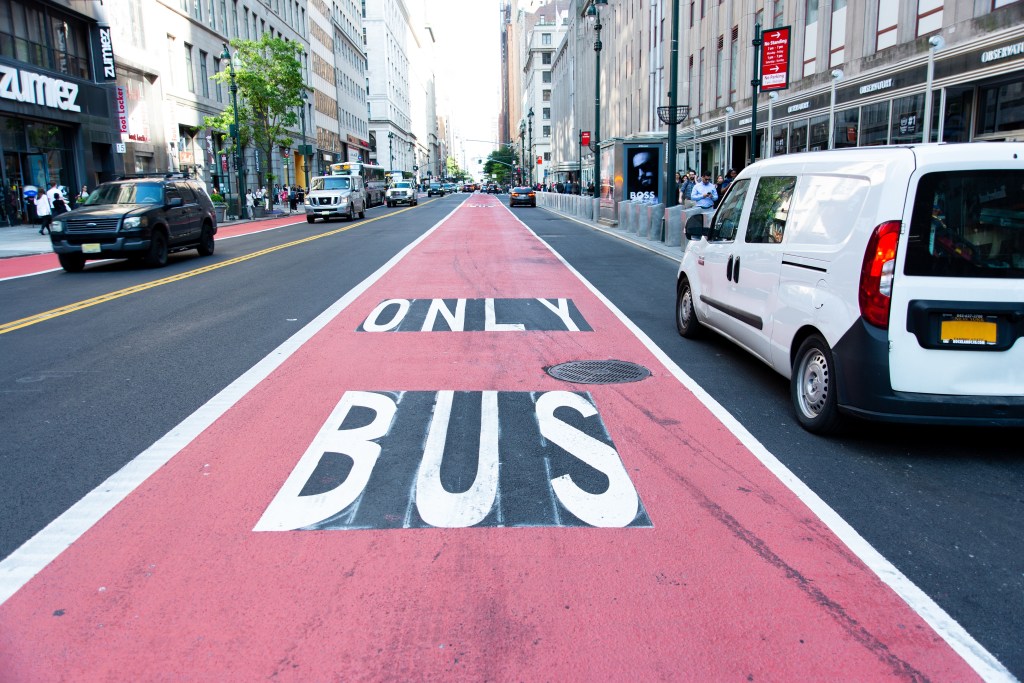Manhattan’s bustling 34th Street is set to undergo a dramatic transformation that will fundamentally reshape how New Yorkers and visitors navigate one of the city’s most critical crosstown corridors. By the end of 2025, the Department of Transportation will implement a comprehensive busway system that prioritizes public transit while significantly restricting private vehicle access—a move that reflects broader urban planning trends toward sustainable transportation.
The Vision: Reimagining Urban Mobility
The ambitious project will convert a substantial stretch of 34th Street into a dedicated busway, where only buses and vehicles serving local businesses will be permitted. This represents one of the most significant transportation infrastructure changes in Midtown Manhattan in decades, with construction scheduled to begin as early as next month.
The Department of Transportation’s initiative aligns with New York City’s broader commitment to reducing traffic congestion, improving air quality, and enhancing public transportation efficiency. The 34th Street corridor, which connects the Hudson River to the East River, serves as a vital artery for cross-Manhattan travel, making it an ideal candidate for this transit-first approach.
Strategic Importance of the 34th Street Corridor
34th Street holds unique significance in Manhattan’s transportation ecosystem. The thoroughfare intersects with multiple subway lines, including the 4, 5, 6 trains at 33rd Street, the N, Q, R, W, B, D, F, M trains at Herald Square, and serves as a gateway to Penn Station—one of the busiest transportation hubs in North America. Additionally, it provides crucial access to the Lincoln Tunnel, making it a primary route for commuters traveling between Manhattan and New Jersey.
The street also anchors major commercial districts, including the Garment District, Koreatown, and the Herald Square shopping area dominated by Macy’s flagship store. This commercial density creates complex transportation demands that the new busway system aims to address more efficiently.
Implementation Timeline and Construction Impact
The DOT’s accelerated timeline reflects the urgency of addressing Manhattan’s transportation challenges. Construction is expected to commence in the coming month, with the full busway operational by December 2025. This rapid implementation schedule suggests extensive preliminary planning and coordination with various city agencies and stakeholders.
During the construction phase, commuters and local businesses should anticipate significant disruptions. The city will need to reconfigure traffic signals, install new signage, modify curb cuts, and potentially adjust sidewalk configurations to accommodate the new traffic patterns. These changes will require careful coordination to minimize economic impact on local businesses while ensuring pedestrian safety.
Economic Implications for Local Businesses
The busway designation creates a nuanced economic landscape for 34th Street businesses. While the restriction on through traffic may initially concern retailers worried about customer accessibility, vehicles serving local businesses will retain access privileges. This provision ensures that deliveries, customer pick-ups, and service vehicles can continue operations, albeit under more regulated conditions.
Historical precedents from other cities suggest that well-implemented busways can actually benefit local commerce by increasing foot traffic from improved public transit service. Faster, more reliable bus service typically brings more potential customers to commercial districts, potentially offsetting any losses from reduced private vehicle access.
Environmental and Public Health Benefits
The environmental implications of the 34th Street busway extend far beyond traffic management. By prioritizing public transit over private vehicles, the project is expected to contribute to significant reductions in greenhouse gas emissions and air pollutants. Buses, particularly when running on compressed natural gas or electric power, produce substantially lower per-passenger emissions compared to private vehicles.
Improved air quality in this densely populated corridor could have measurable public health benefits, particularly for vulnerable populations including children, elderly residents, and individuals with respiratory conditions. The reduction in vehicle exhaust and particulate matter aligns with New York City’s broader environmental justice initiatives.
Transit Efficiency and Commuter Experience
The busway system promises to dramatically improve transit reliability and speed for thousands of daily commuters. Currently, buses along 34th Street frequently experience delays due to mixed traffic conditions, particularly during peak hours. The dedicated lanes should enable more consistent scheduling and reduced travel times across Manhattan.
This improvement is particularly significant given the ongoing challenges at Penn Station, where infrastructure limitations and capacity constraints have created persistent delays for rail commuters. Enhanced bus service along 34th Street provides an alternative transportation option that could alleviate some pressure on the subway system during disruptions.
Challenges and Implementation Concerns
Despite its potential benefits, the 34th Street busway faces several implementation challenges. Enforcement will be crucial to the project’s success, as unauthorized vehicles entering the busway could undermine its effectiveness. The city will need to deploy adequate traffic enforcement resources and potentially implement automated enforcement systems to maintain compliance.
Traffic displacement represents another significant concern. Vehicles currently using 34th Street for crosstown travel will likely migrate to parallel streets, potentially creating new congestion hotspots on 33rd Street, 35th Street, and other nearby corridors. The DOT must carefully monitor these displacement effects and implement complementary traffic management measures as needed.
Broader Urban Planning Context
The 34th Street busway reflects a global trend toward transit-oriented urban development. Cities from Bogotá to Brisbane have successfully implemented similar systems, demonstrating that prioritizing public transit can improve both mobility and quality of life in dense urban environments.
This project also supports New York City’s Vision Zero initiative, which aims to eliminate traffic fatalities and serious injuries. By reducing mixed traffic interactions and creating more predictable traffic patterns, the busway could contribute to improved street safety for all users.
Looking Ahead: Long-term Implications
The success of the 34th Street busway could influence future transportation planning throughout Manhattan and the broader metropolitan area. If the project demonstrates significant improvements in transit efficiency and environmental quality, it may serve as a model for similar implementations on other major crosstown streets.
The initiative also intersects with ongoing discussions about congestion pricing and broader transportation policy reforms. As New York continues to grapple with traffic congestion, air quality concerns, and infrastructure limitations, projects like the 34th Street busway represent practical steps toward more sustainable urban mobility.
Key Takeaways
- Timeline: Construction begins next month with full implementation by end of 2025
- Access: Only buses and vehicles serving local businesses will be permitted
- Strategic Location: 34th Street serves multiple transit hubs and major commercial districts
- Environmental Benefits: Expected reductions in emissions and improved air quality
- Business Impact: Local business access preserved while reducing through traffic
- Enforcement Critical: Success depends on effective traffic law enforcement
- Potential Model: Could influence future busway implementations citywide
This article is based on reporting from the original source

Born and raised amidst the hustle and bustle of the Big Apple, I’ve witnessed the city’s many exciting phases. When I’m not exploring the city or penning down my thoughts, you can find me sipping on a cup of coffee at my favorite local café, playing chess or planning my next trip. For the last twelve years, I’ve been living in South Williamsburg with my partner Berenike.

